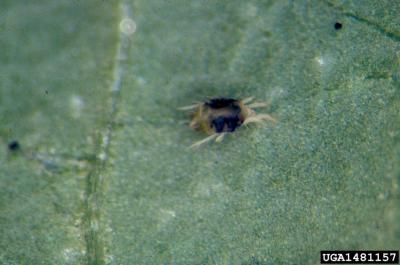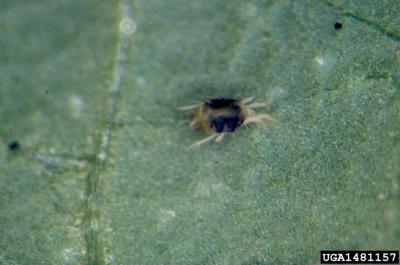August 9, 2018

Source: Iowa State University
According to the U.S. Drought Monitor, southeastern and south central Iowa are experiencing prolonged heat and moisture stress. In early August, there were twospotted spider mites detected in corn and beans. I recommend scouting corn and soybean fields for mite infestations this month, especially in these areas.
Spider mites generally reach economically damaging levels in late July or early August when conditions are favorable for its growth. However, twospotted spider mite can start building populations in June during years with early-season temperatures greater than 85°F, humidity is less than 90 percent, and moisture levels are low. These are ideal conditions for the twospotted spider mite and populations are capable of increasing very rapidly.
Scouting
A hand magnifying lens is recommended to scout for twospotted spider mites (< 1/60 inches long). They can be mistaken for specks of dirt to the naked eye (Photo 1). Twospotted spider mite larvae have six legs, and nymphs and adults have eight legs. Mites can be removed by shaking leaves onto a white piece of paper and then look for moving mites. Twospotted spider mites are typically a cream or green color when feeding on corn or soybean. They can also be an orange to red color when conditions are unfavorable for their growth.

Twospotted spider mite. Photo by Frank Peairs
Twospotted spider mites can aggregate at the field edges, especially if there are weeds surrounding the borders. Eventually they can disperse with the wind to develop a field-wide infestation. I encourage people to look at the edge rows first to see if mites can be found. If their presence is confirmed, then estimate populations throughout the field by walking a “Z” or “W” pattern.
Twospotted spider mites begin feeding on the bottom of the plant, and move to the top as the plant’s health deteriorates. Although they lack wings, twospotted spider mites disperse with the wind to move from dying plants to areas with healthy plants. Therefore, it is important to scout healthy areas of an infested field that are downwind from damaged areas. Early symptoms of twospotted spider mite injury will appear as small yellow dots or stipples on the lower leaves of the plants. Prolonged feeding will cause the infested leaves to turn completely yellow, then brown, and eventually the leaf will die and fall from the plant. The webbing is visible on the edges and underside of leaves, and is an indication of prolonged colony feeding (Photo 2). Twospotted spider mite is capable of reducing soybean yield by 40-60 percent when left untreated; drought-stressed plants could experience even more yield loss.
Heavy twospotted spider mite infestation on corn. Photo by Adam Sisson, Iowa State University.
Management
Exact treatment thresholds for spider mites in corn and soybean do not exist. Instead, the decision to treat should take into consideration how long the field has been infested, mite density including eggs, mite location on the plant, moisture conditions, and plant appearance. A general guideline for soybean is to treat between R1-R5 (i.e., beginning bloom through beginning seed set) when most plants have mites, and heavy stippling and leaf discoloration is apparent on lower leaves (Photo 3). Foliar insecticides are recommended in corn from R1-R4 (i.e., silking through dough stage) when most plants have mites at or around the ear leaf and 15-20 percent leaf discoloration.
Treatment of twospotted spider mites may not be required when temperatures drop below 85°F and humidity levels are greater than 90 percent for an extended time because a naturally-occurring fungus can control populations. Mites that are infected by the fungus will appear brown, and will not move on the piece of paper used for scouting.
Twospotted spider mite injury on soybean. Photo by Whitney Cranshaw, www.ipmimages.org.
Bruce Potter and Ken Ostlie (University of Minnesota) developed a twospotted spider mite rating scale to help make treatment decisions:
0 – no spider mites or injury observed
1 – minor stippling on lower leaves and no premature yellowing observed
2 – stippling common on lower leaves and small areas on scattered plants with yellowing observed
3 – heavy stippling on lower leaves with some stippling progressing into the middle canopy and leaf yellowing and some leaf loss observed; mites scattered in the middle and top canopy [Economic threshold]
4 – lower leaf yellowing readily apparent and leaf drop common; stippling, webbing, and mites common in the middle canopy; mites and minor stippling present in upper canopy [Economic injury]
5 – lower leaf loss common and yellowing moving to the middle canopy; stippling and distortion of upper leaves common; mites in upper canopy observed.
Organophosphates are the recommended insecticidal chemistry for twospotted spider mite control (e.g., dimethoate and chlorpyrifos). Bifenthrin is the only pyrethroid to show efficacy against twospotted mite. Insecticides may not kill the eggs, thus a treated field should be scouted 7-10 days after application to determine if a second application is necessary. As always, refer to the label for the appropriate rates and re-entry intervals. To improve application coverage, consider increasing the water volume to make contact with spider mites. Border treatments may also be a cost-effective option if heavy spider mite populations are restricted to edge rows.
Robert Wright and Julie Peterson from the University of Nebraska-Lincoln summarized a list of pesticide groups labeled for twospotted spider mites in corn and soybean:
Mode of action class 1B; organophosphates
Dimethoate in soybean and corn. E.g., Dimethoate 4E, 4EC, 400, Dimate 4E, 4EC.
Chlorpyrifos in soybean. E.g., Lorsban 4E, Lorsban Advanced, Chlorpyrifos 4E, Govern 4E, Hatchet 4E, NuFos 4E, Warhawk 4E, Yuma 4E.
Mode of action class 3A; pyrethroids
Bifenthrin in soybean and corn. E.g., Bifenture 2E, Brigade 2E, Discipline 2E, Fanfare 2E, Sniper 2E, Tundra 2E.
Mode of action class 6; chloride channel activators
Abamectin in soybean, including spider mite eggs. E.g., Agri-Mek SC.
Mode of action class 10B
Etoxazole in soybean and corn, including spider mite eggs and immatures. E.g., Zeal.
Mode of action class 12C
Propargite in corn. E.g., Comite.
Mode of action class 23; tetronic and tetramic acid derivatives
Spiromesifen in corn, most effective on spider mite eggs and immatures. E.g., Oberon.
Hexythiazox in corn; does not control adult spider mites. E.g., Onager.
Combination products
Hero (zeta-cypermethrin and bifenthrin) labeled for soybean and corn.
Cobalt (chlorpyrifos and gamma-cyhalothrin) labeled for soybean.
Swagger (bifenthrin and imidacloprid) labeled for soybean.
Tundra Supreme (chlorpyrifos and bifenthrin) labeled for soybean and corn.
Originally posted by Iowa State University.
You May Also Like




